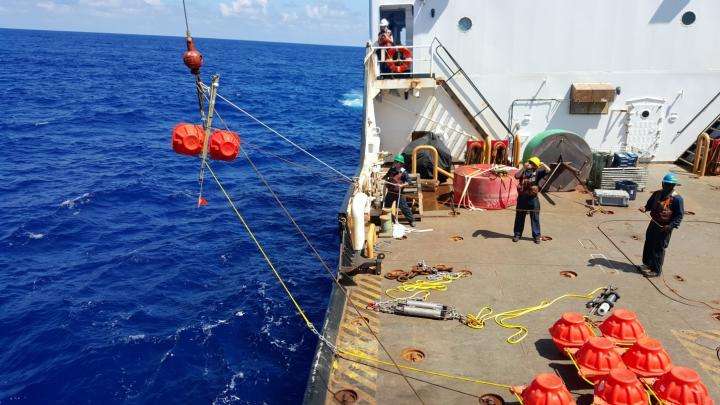Seven miles deep, ocean still a noisy place

For what may be the first time, NOAA and partner scientists eavesdropped on the deepest part of the world's ocean and instead of finding a sea of silence, discovered a cacophony of sounds both natural and caused by humans.
For three weeks, a titanium-encased hydrophone recorded ambient noise from the ocean floor at a depth of more than 36,000 feet, or 7 miles, in the Challenger Deep trough in the Mariana Trench near Micronesia. Researchers from NOAA, Oregon State University, and the U.S. Coast Guard were surprised by how much they heard.
"You would think that the deepest part of the ocean would be one of the quietest places on Earth," said Robert Dziak, a NOAA research oceanographer and chief project scientist. "Yet there is almost constant noise. The ambient sound field is dominated by the sound of earthquakes, both near and far, as well as distinct moans of baleen whales, and the clamor of a category 4 typhoon that just happened to pass overhead."
The hydrophone also picked up sound from ship propellers. Challenger Deep is close to Guam, a regional hub for container shipping with China and the Philippines.
The project, which was funded by the NOAA's Office of Ocean Exploration and Research, was designed to establish a baseline for ambient noise in the deepest part of the Pacific Ocean. Human-created noise has increased steadily in recent decades and getting these first recordings allows scientists in the future to determine if the noise levels are growing and how this might affect marine animals that use sound to communicate, navigate and feed, such as whales, dolphins and fish.
Getting these first recordings wasn't easy in an underwater trough deep enough to hold Mount Everest.
"The pressure at that depth is incredible," said Haru Matsumoto, an Oregon State ocean engineer who worked with NOAA engineer Chris Meinig to adapt the hydrophone. "We had to drop the hydrophone mooring down through the water column at no more than five meters per second to be sure the hydrophone, which is made of ceramic, would survive the rapid pressure change."
While atmospheric pressure in the average home or office is 14.7 pounds per square inch (PSI), it is more than 16,000 PSI at the bottom of the Mariana Trench.
Researchers deployed the hydrophone from the Guam-based U.S. Coast Guard Cutter Sequoia in July 2015. The device recorded sound continuously over 23 days, completely filling the flash drive. However, scientists had to wait until November to retrieve the hydrophone due to ships' schedules and persistent typhoons. The device remained anchored to the seafloor until scientists returned.
Another OSU co-investigator on the project, Joe Haxel, will lead a planned return to Challenger Deep in early 2017, where the researchers will deploy the hydrophone for a longer period of time and attach a deep-ocean camera.
Dziak, Matsumoto, and Haxel all work for NOAA's Pacific Marine Environmental Laboratory in the Acoustics Program located at OSU's Hatfield Marine Science Center. Haxel and Matsumoto are also affiliated with the Cooperative Institute for Marine Resources Studies in Newport, Oregon. The acoustic project in Challenger Deep is one of a number of projects in which the U.S. Coast Guard partners with NOAA to support scientific research.
NOAA's mission is to understand and predict changes in the Earth's environment, from the depths of the ocean to the surface of the sun, and to conserve and manage our coastal and marine resources. Join us on Facebook, Twitter, Instagram and our other social media channels.
Provided by NOAA Headquarters





















